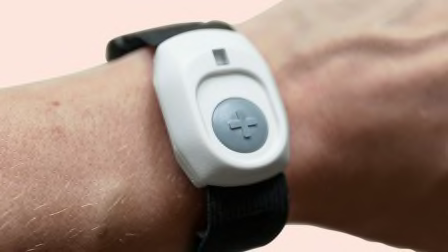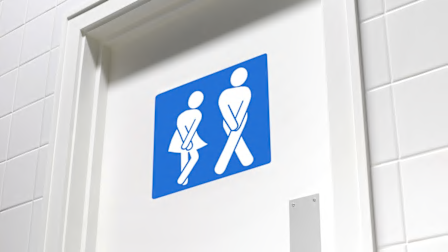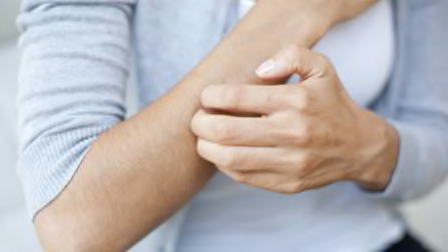Bleach Baths to Treat Eczema Are Popular. But Do They Work?
Evidence suggests that this home remedy may have some benefit as long as it’s done safely

On its face, the idea of using diluted bleach to soothe the itchy, dry, sensitive skin endured by people who have eczema might seem counterintuitive.
But there are plenty who swear by this home remedy, with posts about it garnering millions of views on TikTok. In videos of babies with eczema patches on their cheeks, parents describe how bleach baths helped calm the condition down. “Another flare-up, another bleach bath,” one declares. Another common theme: dermatologists on TikTok assuring viewers that yes, bleach baths are in fact a legitimate treatment.
How Well Do Bleach Baths Work?
First, it’s important to know that baths alone might help with some eczema symptoms. The National Eczema Association recommends lukewarm baths (or showers) of 5 to 10 minutes at least once per day, followed immediately by applying topical medication and moisturizers to keep skin hydrated. The question is: Can adding bleach to some of those baths help?
Over the years, scientists who have done studies to investigate the effectiveness of bleach baths have found mixed results. A 2017 analysis published in the journal Annals of Allergy, Asthma & Immunology that rounded up all the existing research on bleach baths found that they did provide some benefit but were no more effective at reducing eczema symptoms than regular water baths (with no bleach mixed in).
Still, more recent research suggests that bleach baths may do slightly more than regular bathing alone. In an analysis published earlier this year in the same journal, researchers included some more recent studies, including data from some studies that were unpublished. They found that diluted bleach baths did help a bit more than regular bathing. According to the study, out of 100 people with eczema, 22 could expect to see their symptoms improve with regular bathing. Using a bleach bath, however, 32 out of the 100 would see an improvement in symptoms.
An important caveat: Bleach baths appeared to be most effective in people with more severe eczema or those who were experiencing symptom flare-ups. “Many folks with very mild disease, with clear or almost clear skin, may go for a bleach bath, but they may not find it makes much of a difference,” says Chu, one of the study’s authors.
The bottom line? Bleach baths appear to be one potentially useful tool among many possible treatments for reducing eczema symptoms. “It’s a cheap, low-cost intervention, easy enough to do, so I don’t oppose it clinically,” says Jonathan Silverberg, MD, an associate professor of dermatology at the George Washington University School of Medicine and Health Sciences and author of the 2017 analysis. But it may be best to view bleach baths as an adjunct to other eczema therapies that are more solidly backed up by scientific evidence, he says.
A wide variety of such treatments are available, including skin-applied corticosteroids, emollient moisturizers, other prescription topical medications, and some systemic drugs, according to Wolters Kluwer’s UpToDate, a decision-making tool for physicians.
Why Bleach?
The classical thinking about why a diluted bleach bath might work to relieve some eczema symptoms has to do with one of its most well-known properties: Its ability to kill germs.
In the past, scientists have found that people with eczema very commonly have the bacteria Staphylococcus aureus (S. aureus) on their symptomatic skin, and that worse eczema flares are linked to greater amounts of it. So, the theory goes, perhaps a bleach bath might lessen the amount of S. aureus on a person’s eczema-affected skin, thus reducing the severity of their symptoms.
The problem with this theory? In order to safely use a bleach bath, you must greatly dilute the bleach, down to a concentration of about 0.005 percent. A 2019 study in the Journal of Allergy and Clinical Immunology found that, at least in test tubes, that concentration of bleach wasn’t nearly strong enough to kill S. aureus bacteria. The minimum concentration that did work—0.03 percent—is much higher than is safe to use on your skin. (At high concentrations, bleach can cause skin irritation or burning.)
Still, the study was done in test tubes and not on actual human skin, so it can’t completely disprove the bacteria-killing theory. “The body has mechanisms to kill bacteria as well, so it could be working together with bleach,” says Joseph M. Lam, MD, a clinical associate professor in the department of pediatrics at the University of British Columbia. “But it did cast some doubt as to the initial theory of why it works, in terms of the bacterial killing effects.”
Lam says some other preliminary science has suggested an alternative mechanism by which bleach baths may work: That they may have some direct anti-inflammatory effects. But that’s still just a theory and needs more study to be confirmed.
The short answer is that scientists don’t really know yet why bleach baths might be effective when they do work.
Using Bleach Baths Safely
A bleach bath may not work for everyone and is probably best used with other therapies as recommended by your doctor. If you do want to try it, you should take several important steps to make sure you’re using bleach baths safely.
Understand the risks. The studies of diluted bleach baths indicate it’s a fairly low-risk treatment, but there are still some potential problems to be aware of. For one thing, bleach has been known to cause irritation to the nose and lungs, which could be especially problematic for people with asthma. Kids and adults with asthma that isn’t well controlled should work on getting it under control before trying diluted bleach bathing, Chu says. A handy rule, according to Lam, is that if your child with asthma can safely swim in a chlorinated swimming pool, then it’s probably safe for him or her to take a diluted bleach bath.
The other main risk is stinging and burning on eczema-affected skin. Silverberg notes that people with very severe flare-ups may not want to risk such effects.
Check with your doctor. Bleach baths can be safely used for young children and even babies in some cases, but both the National Eczema Association and the American Academy of Dermatology say to check with your doctor before trying it out for the first time.
Dilute the bleach correctly. Experts emphasize that no one should bathe in undiluted bleach, which would be very dangerous. Here’s how to make sure you get the right concentration.
- Use household bleach, and check the label to make sure whatever you’re using has a concentration of about 5 to 6 percent (not higher).
- You’ll want to be most careful with diluting water for an infant to bathe in. Lam recommends using something like an empty 2-liter bottle to fill the tub, so you know how much water you’re using to fill it. From there, he says, the math is easy: However many liters of water you use to fill the tub, that’s how many milliliters of bleach you should stir in.
- For a full-sized tub, with an older child or adult, use a half-cup of bleach in a full tub or a quarter-cup of bleach in a half-full tub. Although bathtubs may not have standardized sizes, Lam says at such high volumes of water, there’s more of a buffer zone for getting the concentration right.
- Make sure the bleach and water are mixed well before bath time begins.
Don’t add anything else to the water. Bleach should not be used with any other products. For example, apple cider vinegar has also been touted as a possible home remedy for eczema, but these two ingredients should never be used together in one bath because the acidic vinegar can react dangerously with the alkaline bleach.
Get the temperature right. Because bleach can create fumes when mixed with hot water, only use lukewarm or cool water for a bleach bath. Avoid using water that’s hot.
Add ventilation. For the same reasons, ventilate the room where you’re using a bleach bath by opening a window or turning on a bathroom fan. (You may want to skip a bleach bath if you have no good ventilation options in your bathroom.)
Limit your bath time. A bleach bath isn’t the time for a long, luxurious bath. Soak for about 10 minutes, the National Eczema Association recommends, and no more than 15.
Keep bleach out of your eyes and mouth. Try to keep babies and kids from splashing any bath water into their eyes. To treat eczema on the face, soak a washcloth in the bleach bath water, wring it out, and dab it onto the face. Never put your child’s head underwater in a bleach bath (or your own).
Rinse off. Once you drain the bleach bath, rinse off completely with fresh water. Follow up with your usual routine of moisturizing and topical skin treatments.
Don’t overdo it. Bathing with diluted bleach every day isn’t necessary. Experts suggest using the treatment just two or three times per week.
@consumerreports Evidence suggests that this home remedy may have some benefit as long as it’s done safely. Learn more at cr.org/health. #skintok #eczema #skincare #bleachbath
♬ original sound - Consumer Reports




















